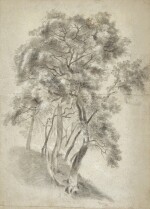A Fine Line: Master Works on Paper from Five Centuries
A Fine Line: Master Works on Paper from Five Centuries

Property from the Collection of the late Cyril and Shirley Fry
Richard Wilson, R.A.
Study of trees on a hillside, probably at Lake Nemi
拍賣已結束
July 7, 10:53 AM GMT
估價
12,000 - 18,000 GBP
拍品資料
描述
Property from the Collection of the late Cyril and Shirley Fry
Richard Wilson, R.A.
Penegoes, Powys 1713/14 - 1782 Colomendy, Clwyd
Study of trees on a hillside, probably at Lake Nemi
Black chalk and stump, heightened with white on grey paper;
inscribed in a later hand lower right: Wilson
518 by 374 mm
Sudbury, Gainsborough's House, From Gainsborough to Constable, 1991, no. 7
Richard Wilson, long considered to be the father of British landscape painting, lived in Italy between 1751 and 1757. These were key years in the Welshman’s life, for settling in Rome, he found himself not only in great demand from Grand Tourists, but also at the centre of an international group of artists lead by Claude-Joseph Vernet and Anton Raphael Mengs, both of whom encouraged him to pursue this particular strand of art.
Wilson explored Rome and its surroundings diligently and with relish, undertaking sketching trips with fellow artists and travelling grandees such as the 4th Earl of Essex and the 10th Earl of Pembroke. He chose to draw en plein air using black chalk and stumping on grey paper – a technique popular with French draughtsman of the period, but not their British counterparts.
The present lot, which is likely to date to circa 1754-6, is a superb example of Wilson’s relatively rare ‘Roman period’ drawings – full of grandeur, subtle light and clearly created after intense study of nature. Although not inscribed, it has been suggested this work was made on the steep banks of Lake Nemi – a spectacular location in the Alban Hills, about 30 kilometers south-east of Rome.
We are grateful to Paul Spencer-Longhurst for his help when cataloguing this lot.
相關推薦










